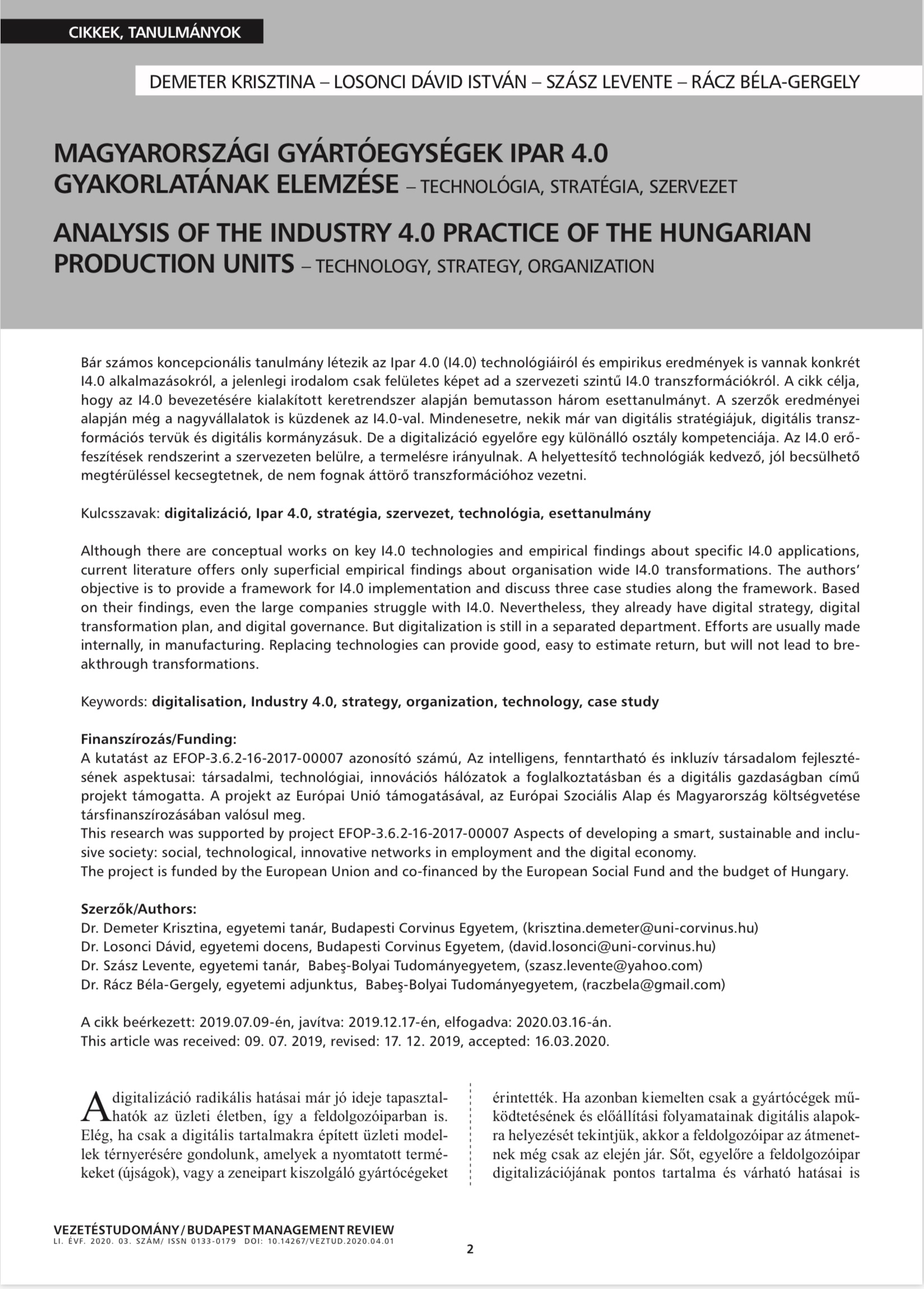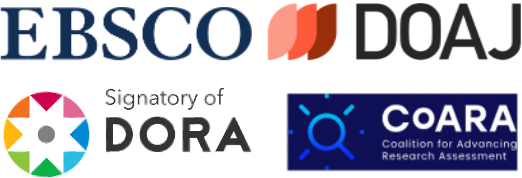Magyarországi gyártóegységek ipar 4.0 gyakorlatának elemzése
Technológia, stratégia, szervezet
DOI:
https://doi.org/10.14267/VEZTUD.2020.04.01Keywords:
digitalisation, Industry 4.0, strategy, organization, technology, case studyAbstract
Although there are conceptual works on key I4.0 technologies and empirical findings about specific I4.0 applications, current literature offers only superficial empirical findings about organisation wide I4.0 transformations. The authors’ objective is to provide a framework for I4.0 implementation and discuss three case studies along the framework. Based on their findings, even the large companies struggle with I4.0. Nevertheless, they already have digital strategy, digital transformation plan, and digital governance. But digitalization is still in a separated department. Efforts are usually made internally, in manufacturing. Replacing technologies can provide good, easy to estimate return, but will not lead to breakthrough transformations.
Downloads
References
Acemoglu, D. (2016). The Impact of IT on the Labor Market. US: Massachusetts Institute of Technology. Retrieved from https://economics.mit.edu/files/12118
Acemoglu, D. (2017. May). Automation and the future of jobs. Toulouse Network for Information Technology (TNIT News). Toulouse: Toulouse School of Economics. Retrieved from https://idei.fr/sites/default/files/IDEI/documents/tnit/newsletter/issue_17.pdf
Andersson, H., & Tuddenham, P. (2014). Reinventing IT to support digitization. New York: McKinsey.
Baker, J. (2012). The technology–organization–environment framework. In Information Systems Theory ( pp. 2 31-245). New York, NY: Springer.
Báthory, Z. (2020). Az értékáram alapú szervezet empirikus vizsgálata öt magyarországi termelő üzem példáján keresztül. Vezetéstudomány, 51(3), 2-16. https://doi.org/10.14267/VEZTUD.2020.03.01
Brettel, M., Friederichsen, N., Keller, M., & Rosenberg, M. (2014). How Virtualization, Decentralization and Network Building Change the Manufacturing Landscape: An Industry 4.0 Perspective. International Scholarly and Scientific Research & Innovation, 8(1), 37-44.
Buer, S.-V., Strandhagen, J. O., & Chan, F. T. (2018). The link between Industry 4.0 and lean manufacturing: mapping current research and establishing a research agenda. International Journal of Production Research, 56(8), 2924-2940. https://doi.org/10.1080/00207543.2018.1442945
Carpenter, H. (2009). Gartner Hype Cycle for Emerging Technologies 2009: What’s Peaking, What’s Troughing?
Retrieved from https://bhc3.com/2009/07/27/gartnerhype-cycle-2009-whats-peaking-whats-troughing/
Chen, Y. S., Chang, C. H., & Wu, F. S. (2012). Origins of green innovations: the differences between proactive and reactive green innovations. Management Decision, 50(3), 368-398. https://doi.org/10.1108/00251741211216197
Cséfalvay, Z. (2017). A nagy korszakváltás. Budapest: Kairosz Kiadó.
Davies, R. (2015). Industry 4.0 Digitalisation for productivity and growth. European Union: European Parliamentary Research Service, European Parlaiment. Retrieved from http://www.europarl.europa.eu/RegData/etudes/BRIE/2015/568337/EPRS_BRI(2015)568337_EN.pdf
De Toni, A., & Tonchia, S. (1996). Lean organization, management by process and performance measurement. International Journal of Operations & Production Management, 16(2), 221-236. https://doi.org/10.1108/01443579610109947
Demeter, K., Losonci, D., Nagy, J., & Horváth, B. (2019). Tapasztalatok az Ipar 4.0-val – egy esetalapú elemzés. Vezetéstudomány, 50(4), 11-23. https://doi.org/10.14267/VEZTUD.2019.04.02
Donaldson, L. (2001). The Contingency Theory ofOrganizations. Thousand Oaks, California: Sage Publications.
Fettermann, D. C., Sá Cavalcante, C. G., de Almeida, T. D., & Tortorella, G. L. (2018). How does Industry 4.0 contribute to operations management?, Journal of Industrial and Production Engineering, 35(4), 255-268. https://doi.org/10.1080/21681015.2018.1462863
Galbraith, J. R. (2010). The multi-dimensional and reconfigurable organization. CEO Publication T10-06 (574). Retrieved from https://ceo.usc.edu/files/2016/10/2010_06-t10_06-Multi_Dimensional_Reconfigurable_Org.pdf
Gartner (n.d.). Gartner Hype Cycle. Retrieved from https://www.gartner.com/en/research/methodologies/gartner-hype-cycle
Gartner, I. (2013). Gartner's 2013 Hype Cycle for Emerging Technologies Maps Out Evolving Relationship BetweenHumans and Machines. Retrieved from https://www.gartner.com/technology/pressRoom.do?id=2575515
Gauger, C., Gehres, B., Quinn, M., Schmieg, F., & Xu, G. (2017). Building the digital car company of the future. USA: The Boston Consulting Group.
Geissbauer, R., Vedso, J., & Schrauf, S. (2016). Industry 4.0: Building the digital enterprise. Retrieved from https://www.pwc.com/gx/en/industries/industries-4.0/landingpage/industry-4.0-building-your-digital-enterpriseapril-2016.pdf
Ghobakhloo, M. (2018). The future of manufacturing industry: a strategic roadmap toward Industry 4.0. Journal of Manufacturing Technology Management, 29(6), 910-936. https//doi:10.1108/JMTM-02-2018-0057
Gilchrist, A. (2016). Industry 4.0: the industrial internet of things. New York, NY: Apress.
Goran, J., LaBerge, L., & Srinivasan, R. (2017). Culture for a digital age. McKinsey&Company. Retrieved from https://www.mckinsey.com/business-functions/digitalmckinsey/our-insights/culture-for-a-digital-age
Horlacher, A., & Hess, T. (2016). What Does a Chief Digital Officer Do? Managerial Tasks and Roles of a New C-level Position in the Context of Digital Transformation. IEEE Computer Society, 49th Hawaii International Conference on System Sciences, 5126-5135. https://doi.org/10.1109/HICSS.2016.63
Horváth, D., & Szabó, Z. R. (2019). Driving forces and barriers of Industry 4.0: Do multinational and small and medium-sized companies have equal opportunities?Technological Forecasting and Social Change, 146, 119-132. https://doi.org/10.1016/j.techfore.2019.05.021
Horváth, D., Móricz, P., & Szabó, Z. R. (2018). Üzletimodellinnováció. Vezetéstudomány, 49(6), 2-12. https://doi.org/10.14267/VEZTUD.2018.06.01
King, W. R., & Teo, T. S. (2000). Assessing the impact of proactive versus reactive modes of strategic information systems planning. Omega, 28(6), 667-679. https://doi.org/10.1016/S0305-0483(99)00079-1
Kotha, S., & Swamidass, P. M. (2000). Strategy, advanced manufacturing technology and performance: empirical evidence from US manufacturing firms. Journal of Operations Management, 18(3), 257-277. https://doi.org/10.1016/S0272-6963(99)00025-X
Lasi, H., Fettke, P., Kemper, H.-G., Feld, T., & Hoffmann, M. (2014). Industrie 4.0. Business and Information Systems Engineering, 6(4), 239-242. https://doi.org/10.1007/s11576-014-0424-4
Legner, C., Eymann, T., Hess, T., Matt, C., Böhmann, T., Drews, P., & Ahlemann, F. (2017). Digitalization: opportunity and challenge for the business and information systems engineering community. Business & Information Systems Engineering, 59(4), 301-308. https://doi.org/10.1007/s12599-017-0484-2
Leonard-Barton, D. (1990). A dual methodology for case studies: Synergistic use of a longitudinal single site with replicated multiple sites. Organization Science, 1(3), 248-266. https://doi.org/10.1287/orsc.1.3.248
Lewis, M. W., & Boyer, K. K. (2002). Factors impacting AMT implementation: an integrative and controlled study. Journal of Engineering and Technology Management, 19(2), 111-130. https://doi.org/10.1016/S0923-4748(02)00005-X
López-Gómez, C., McFarlane, D., O’Sullivan, E., & Velu, C. (2018. szeptember). The practical impact of digital manufacturing: results from recent international experience. Interim Report. Cambridge, United
Kingdom: Policy Links, Institute for Manufacturing (IfM), University of Cambridge. Retrieved from https://www.ifm.eng.cam.ac.uk/uploads/Content_Images/IfM_IUK_Interim_revised.PDF
Losonci, D., Takács, O., & Demeter, K. (2019). Az Ipar 4.0 hatásainak nyomában – a magyarországi járműipar példáján. Közgazdasági Szemle, 66(2), 185-218. https://doi.org/10.18414/KSZ.2019.2.185
Lucianetti, L., Jabbour, C. J., Gunasekaran, A., & Latan, H. (2018). Contingency factors and complementary effects of adopting advanced manufacturing tools and managerial practices: Effects on organizational measurement systems and firms' performance. International Journal of Production Economics, 200, 318-328. https://doi.org/10.1016/j.ijpe.2018.04.005
McKinsey&Company. (2016). Industry 4.0 at McKinsey’s model factories – Get ready for the disruptive wave. McKinsey & Company, Inc. Retrieved from https://capability-center.mckinsey.com/files/mccn/2017-03/digital_ 4.0_model_factories_brochure_2.pdf
Miel, R. (2018). CASE, ACES or SAEV: What will we call electric, shared self-driving cars? Automotive News. Retrieved from https://www.autonews.com/article/20180731/MOBILITY/180739890/case-aces-orsaev-what-will-we-call-electric-shared-self-drivingcars
Mintzberg, H., & Waters, J. A. (1985). Of strategies, deliberate and emergent. Strategic Management Journal 6(3), 257-272. https://doi.org/10.1002/smj.4250060306
Nagy, J. (2019). Az ipar 4.0 fogalma és kritikus kérdései – vállalati interjúk alapján. Vezetéstudomány, 50, 1, 14-26. https://doi.org/10.14267/VEZTUD.2019.01.02
Netland, T. (2013). Exploring the phenomenon of companyspecific production systems. International Journal of Production Research, 51(4), 1084–1097. https://doi.org/10.1080/00207543.2012.676686
O'Regan, N., & Ghobadian, A. (2002). Formal strategic planning: the key to effective business process management? Business Process Management Journal, 8(5), 416-429. https://doi.org/10.1108/14637150210449102
Panetta, K. (2018). 5 Trends Emerge in the Gartner Hype Cycle for Emerging Technologies, 2018. Retrieved from https://www.gartner.com/smarterwithgartner/5-trends-emerge-in-gartner-hype-cycle-for-emergingtechnologies-2018/
Pires, G. D., & Aisbett, J. (2003). The relationship between technology adoption and strategy in business-tobusiness markets: the case of e-commerce. Industrial Marketing Management, 32(4), 291-300. https://doi.org/10.1016/S0019-8501(02)00237-7
Porter, M. E., & Heppelmann, J. E. (2014). How smart, connected products are transforming competition. Harvard Business Review, 92(11), 64-88.
Roland Berger (2016). Digital factories – The renaissance of the U.S. automotive industry. Munich, Germany: Roland Berger. Retrieved from https://www.rolandberger.com/publications/publication_pdf/roland_berger_tab_digital_factories_20160217.pdf
Schlechtendahl, J., Keinert, M., Kretschmer, F., Lechler, A.,& Verl, A. (2015). Making existing production systems Industry 4.0-ready. Production Engineering, 9(1), 143-148. https://doi.org/10.1007/s11740-014-0586-3
Schwab, K. (2016). The Fourth Industrial Revolution. London: Portfolio Penguin.
Slack, N., Chambers, S., & Johnston, R. (2010). Operations management. Harlow: Prentice Hall, Financial Times.
Sousa, R., & Voss, C. A. (2008). Contingency research in operations management practices. Journal of Operations Management, 26(6), 697-713. https://doi.org/10.1016/j.jom.2008.06.001
Stock, G. N., & McDermott, C. M. (2001). Organizational and strategic predictors of manufacturing technology implementation success: an exploratory study. Technovation, 21(10), 625-636. https://doi.org/10.1016/S0166-4972(01)00051-7
Szabó, Z. R., Horváth, D., & Hortoványi, L. (2019). Hálózati tanulás az ipar 4.0 korában. Közgazdasági Szemle, 66(1), 72-94. https://doi.org/10.18414/KSZ.2019.1.72
Tornatzky, L., & Fleischer, M. (1990). The process of technology innovation. Lexington, MA: Lexington Book.
Valenduc, G., & Vendramin, P. (2016). Work in the digital economy: sorting the old from the new. ETUI, Brussels. Retrieved from https://www.etui.org/Publications2/Working-Papers/Work-in-the-digital-economy-sortingthe-old-from-the-new
Viharos, Z., Soós, S., Nick, G., Várgedő, T., & Beregi, R. (2017). Non-comparative, Industry 4.0 Readiness. Budapest: 15th IMEKO TC10 Workshop on Technical Diagnostics. Retrieved from http://eprints.sztaki.hu/9238/1/Viharos_181_3257460_ny.pdf
Zaltman, G., Duncan, R., & Holbek, J. (1973). Innovations and organizations. New Jersey: John Wiley & Sons.

Downloads
Published
How to Cite
Issue
Section
License
Authors assign copyright to Vezetéstudomány / Budapest Management Review. Authors are responsible for permission to reproduce copyright material from other sources.

